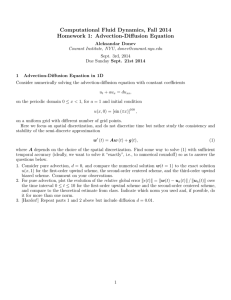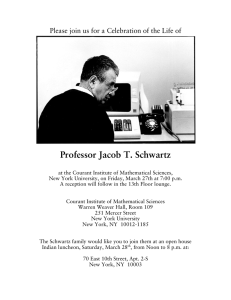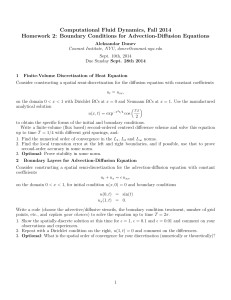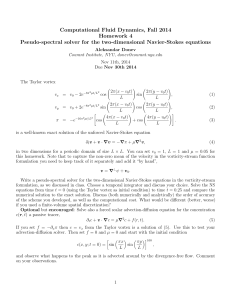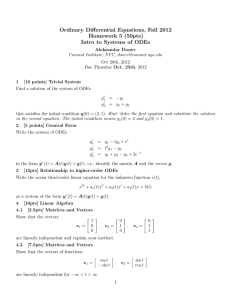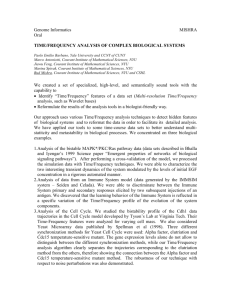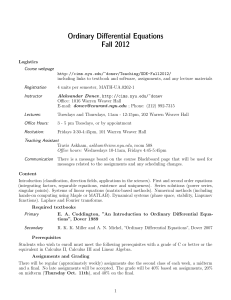Scientific Computing: Dense Linear Systems Aleksandar Donev Courant Institute, NYU
advertisement
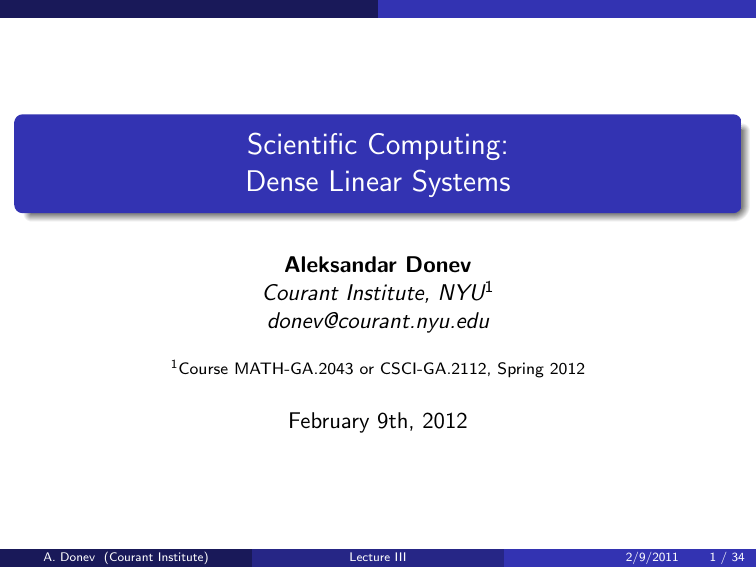
Scientific Computing:
Dense Linear Systems
Aleksandar Donev
Courant Institute, NYU1
donev@courant.nyu.edu
1 Course
MATH-GA.2043 or CSCI-GA.2112, Spring 2012
February 9th, 2012
A. Donev (Courant Institute)
Lecture III
2/9/2011
1 / 34
Outline
1
Linear Algebra Background
2
Conditioning of linear systems
3
Gauss elimination and LU factorization
4
Conclusions
A. Donev (Courant Institute)
Lecture III
2/9/2011
2 / 34
Linear Algebra Background
Linear Spaces
A vector space V is a set of elements called vectors x ∈ V that may
be multiplied by a scalar c and added, e.g.,
z = αx + βy
I will denote scalars with lowercase letters and vectors with lowercase
bold letters.
Prominent examples of vector spaces are Rn (or more generally Cn ),
but there are many others, for example, the set of polynomials in x.
0
A subspace V ⊆ V of a vector space is a subset such that sums and
0
0
multiples of elements of V remain in V (i.e., it is closed).
An example is the set of vectors in x ∈ R3 such that x3 = 0.
A. Donev (Courant Institute)
Lecture III
2/9/2011
3 / 34
Linear Algebra Background
Image Space
Consider a set of n vectors a1 , a2 , · · · , an ∈ Rm and form a matrix by
putting these vectors as columns
A = [a1 | a2 | · · · | am ] ∈ Rm,n .
I will denote matrices with bold capital letters, and sometimes write
A = [m, n] to indicate dimensions.
The matrix-vector product is defined as a linear combination of
the columns:
b = Ax = x1 a1 + x2 a2 + · · · + xn an ∈ Rm .
The image im(A) or range range(A) of a matrix is the subspace of
all linear combinations of its columns, i.e., the set of all b0 s.
It is also sometimes called the column space of the matrix.
A. Donev (Courant Institute)
Lecture III
2/9/2011
4 / 34
Linear Algebra Background
Dimension
The set of vectors a1 , a2 , · · · , an are linearly independent or form a
basis for Rm if b = Ax = 0 implies that x = 0.
The dimension r = dimV of a vector (sub)space V is the number of
elements in a basis. This is a property of V itself and not of the basis,
for example,
dim Rn = n
Given a basis A for a vector space V of dimension n, every vector of
b ∈ V can be uniquely represented as the vector of coefficients x in
that particular basis,
b = x1 a1 + x2 a2 + · · · + xn an .
A simple and common basis for Rn is {e1 , . . . , en }, where ek has all
components zero except for a single 1 in position k.
With this choice of basis the coefficients are simply the entries in the
vector, b ≡ x.
A. Donev (Courant Institute)
Lecture III
2/9/2011
5 / 34
Linear Algebra Background
Kernel Space
The dimension of the column space of a matrix is called the rank of
the matrix A ∈ Rm,n ,
r = rank A ≤ min(m, n).
If r = min(m, n) then the matrix is of full rank.
The nullspace null(A) or kernel ker(A) of a matrix A is the subspace
of vectors x for which
Ax = 0.
The dimension of the nullspace is called the nullity of the matrix.
For a basis A the nullspace is null(A) = {0} and the nullity is zero.
A. Donev (Courant Institute)
Lecture III
2/9/2011
6 / 34
Linear Algebra Background
Orthogonal Spaces
An inner-product space is a vector space together with an inner or
dot product, which must satisfy some properties.
The standard dot-product in Rn is denoted with several different
notations:
n
X
T
x · y = (x, y) = hx, yi = x y =
xi yi .
i=1
Cn
For
we need to add complex conjugates (here ? denotes a complex
conjugate transpose, or adjoint),
?
x·y =x y =
n
X
x̄i yi .
i=1
Two vectors x and y are orthogonal if x · y = 0.
A. Donev (Courant Institute)
Lecture III
2/9/2011
7 / 34
Linear Algebra Background
Part I of Fundamental Theorem
One of the most important theorems in linear algebra is that the sum
of rank and nullity is equal to the number of columns: For A ∈ Rm,n
rank A + nullity A = n.
In addition to the range and kernel spaces of a matrix, two more
important vector subspaces for a given matrix A are the:
Row space or coimage of a matrix is the column (image) space of its
transpose, im AT .
Its dimension is also equal to the the rank.
Left nullspace or cokernel of a matrix is the nullspace or kernel of its
transpose, ker AT .
A. Donev (Courant Institute)
Lecture III
2/9/2011
8 / 34
Linear Algebra Background
Part II of Fundamental Theorem
The orthogonal complement V ⊥ or orthogonal subspace of a
subspace V is the set of all vectors that are orthogonal to every vector
in V.
Let V be the set of vectors in x ∈ R3 such that x3 = 0. Then V ⊥ is
the set of all vectors with x1 = x2 = 0.
Second fundamental theorem in linear algebra:
im AT = (ker A)⊥
ker AT = (im A)⊥
A. Donev (Courant Institute)
Lecture III
2/9/2011
9 / 34
Linear Algebra Background
Linear Transformation
A function L : V → W mapping from a vector space V to a vector
space W is a linear function or a linear transformation if
L(αv) = αL(v) and L(v1 + v2 ) = L(v1 ) + L(v2 ).
Any linear transformation L can be represented as a multiplication by
a matrix L
L(v) = Lv.
For the common bases of V = Rn and W = Rm , the product w = Lv
is simply the usual matix-vector product,
wi =
n
X
Lik vk ,
k=1
which is simply the dot-product between the i-th row of the matrix
and the vector v.
A. Donev (Courant Institute)
Lecture III
2/9/2011
10 / 34
Linear Algebra Background
Matrix algebra
wi = (Lv)i =
n
X
Lik vk
k=1
The composition of two linear transformations A = [m, p] and
B = [p, n] is a matrix-matrix product C = AB = [m, n]:
z = A (Bx) = Ay = (AB) x
zi =
n
X
Aik yk =
k=1
p
X
k=1
Aik
n
X
Bkj xj =
j=1
p
n
X
X
j=1
Cij =
p
X
k=1
!
Aik Bkj
xj =
n
X
Cij xj
j=1
AIk Bkj
k=1
Matrix-matrix multiplication is not commutative, AB 6= BA in
general.
A. Donev (Courant Institute)
Lecture III
2/9/2011
11 / 34
Linear Algebra Background
The Matrix Inverse
A square matrix A = [n, n] is invertible or nonsingular if there exists
a matrix inverse A−1 = B = [n, n] such that:
AB = BA = I,
where I is the identity matrix (ones along diagonal, all the rest zeros).
The following statements are equivalent for A ∈ Rn,n :
A is invertible.
A is full-rank, rank A = n.
The columns and also the rows are linearly independent and form a
basis for Rn .
The determinant is nonzero, det A 6= 0.
Zero is not an eigenvalue of A.
A. Donev (Courant Institute)
Lecture III
2/9/2011
12 / 34
Linear Algebra Background
Matrix Algebra
Matrix-vector multiplication is just a special case of matrix-matrix
multiplication. Note xT y is a scalar (dot product).
C (A + B) = CA + CB and ABC = (AB) C = A (BC)
AT
A−1
−1
T
= A and (AB)T = BT AT
= A and (AB)−1 = B−1 A−1 and AT
−1
= A−1
T
Instead of matrix division, think of multiplication by an inverse:
(
B = A−1 C
AB = C ⇒
A−1 A B = A−1 C ⇒
A = CB−1
A. Donev (Courant Institute)
Lecture III
2/9/2011
13 / 34
Linear Algebra Background
Vector norms
Norms are the abstraction for the notion of a length or magnitude.
For a vector x ∈ Rn , the p-norm is
kxkp =
n
X
!1/p
|xi |p
i=1
and special cases of interest are:
1
2
3
1
Pn
The 1-norm (L1 norm or Manhattan distance), kxk1 = i=1 |xi |
The 2-norm (L2 norm,
qP Euclidian distance),
√
n
2
kxk2 = x · x =
i=1 |xi |
∞
The ∞-norm (L or maximum norm), kxk∞ = max1≤i≤n |xi |
Note that all of these norms are inter-related in a finite-dimensional
setting.
A. Donev (Courant Institute)
Lecture III
2/9/2011
14 / 34
Linear Algebra Background
Matrix norms
Matrix norm induced by a given vector norm:
kAxk
x6=0 kxk
kAk = sup
⇒ kAxk ≤ kAk kxk
The last bound holds for matrices as well, kABk ≤ kAk kBk.
Special cases of interest are:
1
2
3
4
Pn
The 1-norm or column sum norm, kAk1 = maxP
j
i=1 |aij |
n
The ∞-norm or row sum norm, kAk∞ = maxi j=1 |aij |
The 2-norm or spectral norm, kAk2 = σ1 (largest
qP singular value)
2
The Euclidian or Frobenius norm, kAkF =
i,j |aij |
(note this is not an induced norm)
A. Donev (Courant Institute)
Lecture III
2/9/2011
15 / 34
Conditioning of linear systems
Matrices and linear systems
It is said that 70% or more of applied mathematics research involves
solving systems of m linear equations for n unknowns:
n
X
aij xj = bi ,
i = 1, · · · , m.
j=1
Linear systems arise directly from discrete models, e.g., traffic flow
in a city. Or, they may come through representing or more abstract
linear operators in some finite basis (representation).
Common abstraction:
Ax = b
Special case: Square invertible matrices, m = n, det A 6= 0:
x = A−1 b.
The goal: Calculate solution x given data A, b in the most
numerically stable and also efficient way.
A. Donev (Courant Institute)
Lecture III
2/9/2011
16 / 34
Conditioning of linear systems
Stability analysis: rhs perturbations
Perturbations on right hand side (rhs) only:
A (x + δx) = b + δb
δx = A−1 δb
⇒ b + Aδx = b + δb
⇒ kδxk ≤ A−1 kδbk
Using the bounds
kbk ≤ kAk kxk
⇒ kxk ≥ kbk / kAk
the relative error in the solution can
−1 A kδbk
kδxk
≤
≤
kxk
kxk
be bounded by
−1 A kδbk
kδbk
= κ(A)
kbk / kAk
kbk
where the conditioning number κ(A) depends on the matrix norm used:
κ(A) = kAk A−1 ≥ 1.
A. Donev (Courant Institute)
Lecture III
2/9/2011
17 / 34
Conditioning of linear systems
Stability analysis: matrix perturbations
Perturbations of the matrix only:
(A + δA) (x + δx) = b
⇒ δx = −A−1 (δA) (x + δx)
kδxk
kδAk
≤ A−1 kδAk = κ(A)
.
kx + δxk
kAk
Conclusion: The worst-case conditioning of the linear system is
determined by
κ(A) = kAk A−1 ≥ 1
Solving an ill-conditioned system, κ(A) 1, should only be done if
something is known about x or b (e.g., smooth solutions in PDEs).
The conditioning number can only be estimated in practice since
A−1 is not available (see MATLAB’s rcond function).
A. Donev (Courant Institute)
Lecture III
2/9/2011
18 / 34
Conditioning of linear systems
Mixed perturbations
Now consider general perturbations of the data:
(A + δA) (x + δx) = b + δb
The full derivation, not given here, estimates the uncertainty or
perturbation in the solution:
κ(A)
kδbk kδAk
kδxk
≤
+
kxk
kAk
1 − κ(A) kδAk kbk
kAk
Best possible error with rounding unit u u ≈ 10−16 :
kδxk∞
. 2uκ(A),
kxk∞
which is close to what the MATLAB linear solvers achieve.
It certainly makes no sense to try to solve systems with κ(A) > 1015 !
A. Donev (Courant Institute)
Lecture III
2/9/2011
19 / 34
Gauss elimination and LU factorization
GEM: Eliminating x1
A. Donev (Courant Institute)
Lecture III
2/9/2011
20 / 34
Gauss elimination and LU factorization
GEM: Eliminating x2
A. Donev (Courant Institute)
Lecture III
2/9/2011
21 / 34
Gauss elimination and LU factorization
GEM: Backward substitution
A. Donev (Courant Institute)
Lecture III
2/9/2011
22 / 34
Gauss elimination and LU factorization
GEM as an LU factorization tool
We have actually factorized A as
A = LU,
L is unit lower triangular (lii = 1 on diagonal), and U is upper
triangular.
GEM is thus essentially the same as the LU factorization method.
A. Donev (Courant Institute)
Lecture III
2/9/2011
23 / 34
Gauss elimination and LU factorization
GEM in MATLAB
Sample MATLAB code (for learning purposes only, not real computing!):
f u n c t i o n A = MyLU(A)
% LU f a c t o r i z a t i o n i n −p l a c e ( o v e r w r i t e A)
[ n ,m]= s i z e (A ) ;
i f ( n ˜= m) ; e r r o r ( ’ M a t r i x n o t s q u a r e ’ ) ; end
f o r k =1:( n−1) % For v a r i a b l e x ( k )
% C a l c u l a t e m u l t i p l i e r s i n column k :
A ( ( k +1): n , k ) = A ( ( k +1): n , k ) / A( k , k ) ;
% Note : P i v o t e l e m e n t A( k , k ) assumed n o n z e r o !
f o r j =(k +1): n
% Eliminate variable x(k ):
A ( ( k +1): n , j ) = A ( ( k +1): n , j ) − . . .
A ( ( k +1): n , k ) ∗ A( k , j ) ;
end
end
end
A. Donev (Courant Institute)
Lecture III
2/9/2011
24 / 34
Gauss elimination and LU factorization
Pivoting
A. Donev (Courant Institute)
Lecture III
2/9/2011
25 / 34
Gauss elimination and LU factorization
Pivoting during LU factorization
Partial (row) pivoting permutes the rows (equations) of A in order
to ensure sufficiently large pivots and thus numerical stability:
PA = LU
Here P is a permutation matrix, meaning a matrix obtained by
permuting rows and/or columns of the identity matrix.
Complete pivoting also permutes columns, PAQ = LU.
A. Donev (Courant Institute)
Lecture III
2/9/2011
26 / 34
Gauss elimination and LU factorization
Gauss Elimination Method (GEM)
GEM is a general method for dense matrices and is commonly used.
Implementing GEM efficiently and stably is difficult and we will not
discuss it here, since others have done it for you!
The LAPACK public-domain library is the main repository for
excellent implementations of dense linear solvers.
MATLAB uses a highly-optimized variant of GEM by default, mostly
based on LAPACK.
MATLAB does have specialized solvers for special cases of matrices,
so always look at the help pages!
A. Donev (Courant Institute)
Lecture III
2/9/2011
27 / 34
Gauss elimination and LU factorization
Solving linear systems
Once an LU factorization is available, solving a linear system is simple:
Ax = LUx = L (Ux) = Ly = b
so solve for y using forward substitution.
This was implicitly done in the example above by overwriting b to
become y during the factorization.
Then, solve for x using backward substitution
Ux = y.
If row pivoting is necessary, the same applies but L or U may be
permuted upper/lower triangular matrices,
e = PT L U.
A = LU
A. Donev (Courant Institute)
Lecture III
2/9/2011
28 / 34
Gauss elimination and LU factorization
In MATLAB
In MATLAB, the backslash operator (see help on mldivide)
x = A\b ≈ A−1 b,
solves the linear system Ax = b using the LAPACK library.
Never use matrix inverse to do this, even if written as such on paper.
Doing x = A\b is equivalent to performing an LU factorization and
doing two triangular solves (backward and forward substitution):
[L̃, U] = lu(A)
y = L̃\b
x = U\y
This is a carefully implemented backward stable pivoted LU
factorization, meaning that the returned solution is as accurate as the
conditioning number allows.
A. Donev (Courant Institute)
Lecture III
2/9/2011
29 / 34
Gauss elimination and LU factorization
GEM Matlab example (1)
>> A = [ 1
2
>> b =[2 1 − 1 ] ’ ;
3 ;
4
5
6 ;
7
8
0 ];
>> x=Aˆ( −1)∗ b ; x ’ % Don ’ t do t h i s !
ans =
−2.5556
2.1111
0.1111
>> x = A\b ; x ’ % Do t h i s i n s t e a d
ans =
−2.5556
2.1111
0.1111
>> l i n s o l v e (A , b ) ’ % Even more c o n t r o l
ans =
−2.5556
2.1111
0.1111
A. Donev (Courant Institute)
Lecture III
2/9/2011
30 / 34
Gauss elimination and LU factorization
GEM Matlab example (2)
>> [ L , U ] = l u (A) % Even b e t t e r i f r e s o l v i n g
L =
U =
0.1429
0.5714
1.0000
7.0000
0
0
1.0000
0.5000
0
8.0000
0.8571
0
0
1.0000
0
0
3.0000
4.5000
>> norm ( L∗U−A , i n f )
ans =
0
>> y = L\b ;
>> x = U\ y ; x ’
ans =
−2.5556
A. Donev (Courant Institute)
2.1111
Lecture III
0.1111
2/9/2011
31 / 34
Gauss elimination and LU factorization
Cost estimates for GEM
For forward or backward substitution, at step k there are ∼ (n − k)
multiplications and subtractions, plus a few divisions.
The total over all n steps is
n
X
n(n − 1)
n2
(n − k) =
≈
2
2
k=1
subtractions and multiplications, giving a total of O(n2 )
floating-point operations (FLOPs).
The LU factorization itself costs a lot more, O(n3 ),
FLOPS ≈
2n3
,
3
and the triangular solves are negligible for large systems.
When many linear systems need to be solved with the same A the
factorization can be reused.
A. Donev (Courant Institute)
Lecture III
2/9/2011
32 / 34
Conclusions
Matrix Rescaling
Pivoting is not always sufficient to ensure lack of roundoff problems.
In particular, large variations among the entries in A should be
avoided.
This can usually be remedied by changing the physical units for x and
b to be the natural units x0 and b0 .
Rescaling the unknowns and the equations is generally a good idea
even if not necessary:
x = Dx x̃ = Diag {x0 } x̃ and b = Db b̃ = Diag {b0 } b̃.
Ax = ADx x̃ = Db b̃
⇒
D−1
b ADx x̃ = b̃
e = D−1 ADx should have a better
The rescaled matrix A
b
conditioning.
Also note that reordering the variables from most important to
least important may also help.
A. Donev (Courant Institute)
Lecture III
2/9/2011
33 / 34
Conclusions
Conclusions/Summary
The conditioning of a linear system Ax = b is determined by the
condition number
κ(A) = kAk A−1 ≥ 1
Gauss elimination can be used to solve general square linear systems
and also produces a factorization A = LU.
Partial pivoting is often necessary to ensure numerical stability during
e
GEM and leads to PA = LU or A = LU.
MATLAB has excellent linear solvers based on well-known public
domain libraries like LAPACK. Use them!
A. Donev (Courant Institute)
Lecture III
2/9/2011
34 / 34
